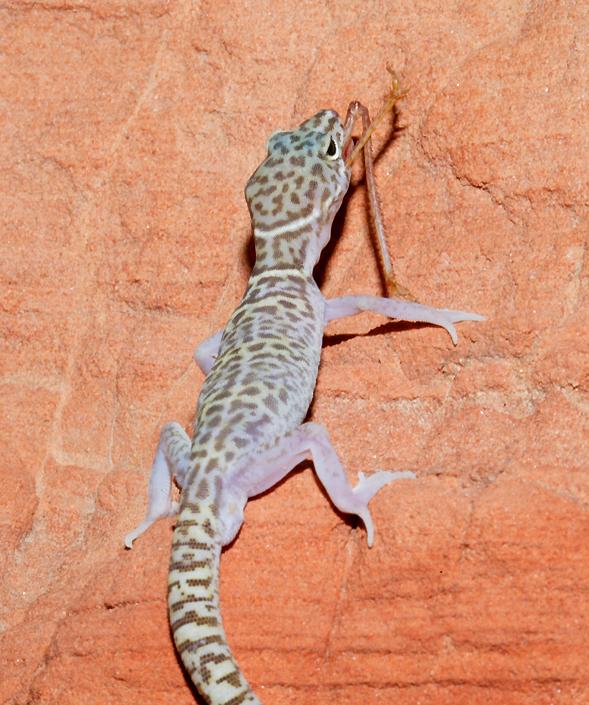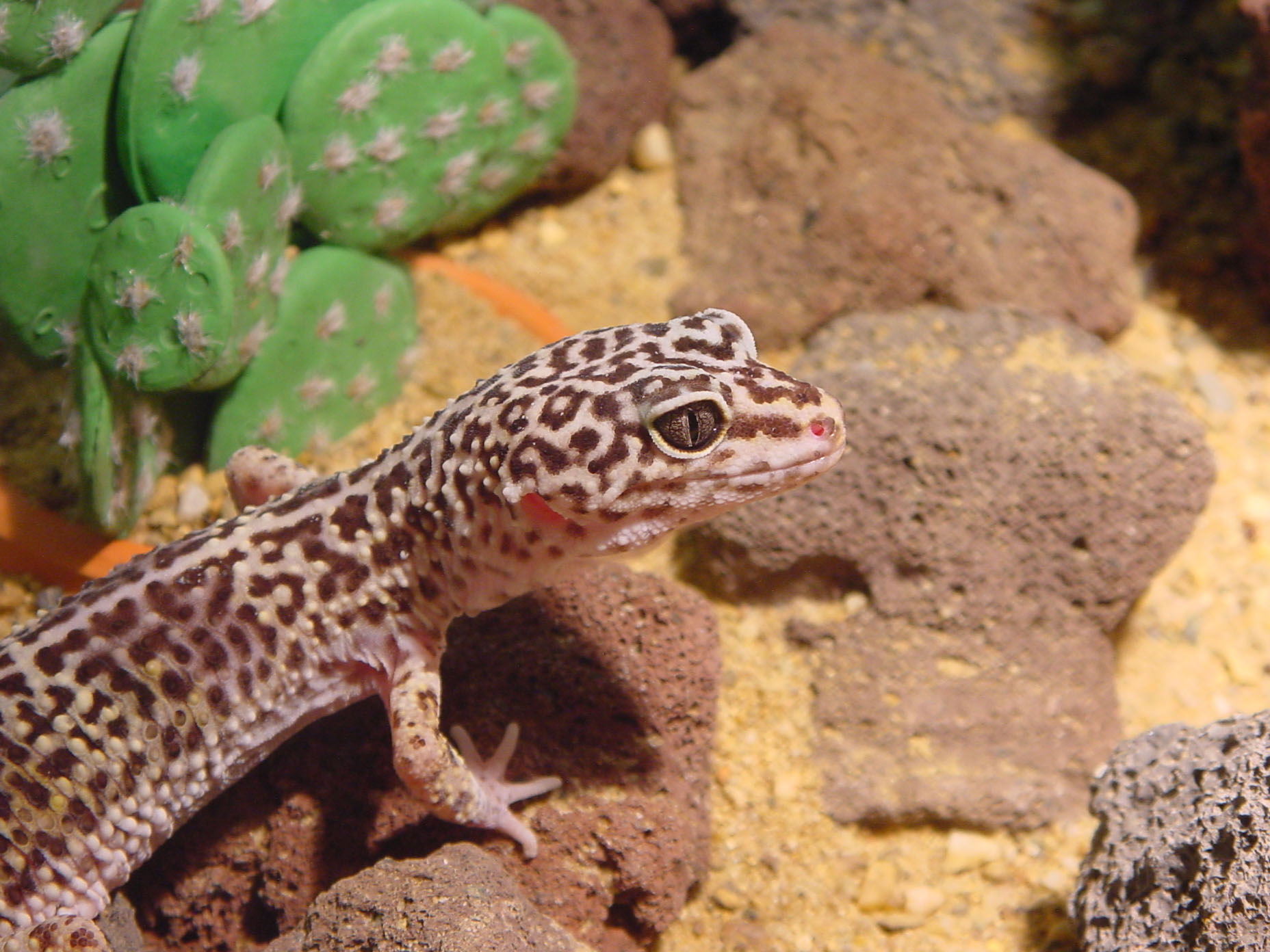Espero que saibas ingles
Fonte wikipedia online
Gecko
From Wikipedia, the free encyclopedia
Tokay Gecko
Scientific classification
Kingdom: Animalia
Phylum: Chordata
Class: Reptilia
Order: Squamata
Suborder: Lacertilia
Family: Gekkonidae
Gray, 1825
Subfamilies
Aeluroscalabotinae
Eublepharinae
Gekkoninae
Teratoscincinae
Diplodactylinae
Geckos are small to moderately large lizards belonging to the family Gekkonidae which are found in warm climates throughout the world. Geckos are unique among lizards in their vocalizations, making chirping sounds in social interactions with other geckos. Geckos are unusual in other respects as well. Most geckos have no eyelids and instead have a transparent membrane which they lick to clean. A few species have the ability to shoot an irritating liquid out of the end of their tails. They are also known to have the ability to change the colour of their skins although they have not mastered it like the chameleons and can only go pale. Many species have specialized toe pads that enable them to climb smooth vertical surfaces and even cross indoor ceilings with ease. These antics are well-known to people who live in warm regions of the world where several species of geckos make their home inside human habitations. These species (for example the House gecko) become part of the indoor menagerie and are seldom really discouraged because they feed on insect pests.
Most geckos are tan to dark grey, subtly patterned, and somewhat rubbery looking. Some species can change color to blend in with their surroundings or with temperature differences. However others can be brightly colored.
Some species are parthenogenic, the females capable of reproducing without copulating with a male. This improves the geckos' ability to spread to new islands.
The toes of the gecko have attracted a lot of attention, as they adhere to a wide variety of surfaces, without the use of liquids or surface tension. Recent studies of the Spatula tipped setae on gecko footpads demonstrates that the attractive forces that hold geckos to surfaces are van der Waals interactions between the finely divided setae (almost 500,000 Setae on each foot, and each of these tipped with between 100 and 1,000 spatulae) and the surfaces themselves. These kinds of interactions involve no fluids; in theory, a boot made of synthetic setae would adhere as easily to the surface of the International Space Station as it would to a living room wall. Geckos toes are extremely double jointed, allowing them to overcome the van der Waals force by peeling their toes off surfaces from the tips inward. In essence, this peeling action alters the angle of incidence between millions of individual setae and the surface, reducing the van der Waals force. Amazingly, Geckos' toes operate well below their full attractive capabilities for most of the time. This is because there is a huge margin for error depending upon the roughness of the surface, and therefore the number of Spatulae in contact with that surface. If a gecko had every one of its spatulae in contact with a surface, it would be capable of holding aloft a 120Kg man.
The family Gekkonidae is divided into five different subfamilies, containing numerous different genera of gecko species. Many geckos are kept as pets and will eat various kinds of insects and sometimes fruit.
In the past few years, geckos have entered the collective consciousness as the advertising icon for the insurance company GEICO, whose television advertisements feature an animated anthropomorphic gecko character that speaks English with a South London (England) accent.
[edit] Common species of gecko
Bibrons Gecko Pachydactylus bibroni. Native to Southern Africa, this hardy arboreal gecko is relatively common as a pet.
Crested Gecko, Rhacodactylus ciliatus — Until recently believed extinct. Gaining in popularity as a pet.
Crocodile or Moorish gecko, Tarentola mauritanica — Crocodile geckos are very strong and heavily built for their size usually growing up to 15.24 cm (6 in). They are commonly found in the Mediterranean region from the Iberian Peninsula and southern France to Greece and northern Africa. Their most distinguishing characteristic is their pointed head and spiked skin with their tail resembling that of a crocodile's.
Gargoyle Gecko, Rhacodactylus auriculatus — commonly known as the New Caledonian bumpy gecko or Gargoyle gecko.
Golden gecko, Gekko ulikovski — native to the warm rainforests of Vietnam.
House Gecko, Hemidactylus frenatus — A species that thrives around man and human habitation structures in the tropics and subtropics world wide.
Indo-Pacific gecko, Hemidactylus garnoti — Also known as a fox gecko because of its long, narrow snout. This species is found in houses throughout the tropics. This gecko may eat leafcutter ants.
Leachianus Giant Gecko, Rhacodactylus leachianus — first described by Cuvier in 1829, is the largest of the Rhacodactylus geckos.
Leopard gecko, Eublepharis macularius — The most common gecko kept as a pet is the leopard gecko, which does not have toe pads with setae, but rather claws. These enable it to more easily climb on rough surfaces like tree bark. This gecko cannot climb the glass of a terrarium. The leopard gecko tends to be docile and calm. This gecko can eat butterworms, cockroaches, crickets, mealworms, waxworms, and superworms.
Mediterranean gecko, Hemidactylus turcicus — residential and wild, introduced species (USA).
Mourning gecko, Lepidodactylus lugubris — This species is equally at home in the wild as in residential neighborhoods. Found in Hawaii, it may have been an early Polynesian introduction. A parthenogenic species. One guy on Maui reports having seen a larger gecko of this type eating a smaller one (or rather, running away from view with a smaller gecko halfway out of its mouth) on two occasions.
Stump-toed gecko, Gehyra mutilata (Peropus mutilatus) — This gecko can vary its color from very light to very dark to blend into a background. At home in the wild as well as in residential neighborhoods.
Tree gecko, Hemiphyllodactylus typus — Tree geckos are forest dwellers.
Tokay Gecko, Gekko Gecko — a large, common, Southeast Asian gecko known for its aggressive temperament, loud mating calls, and bright markings.






